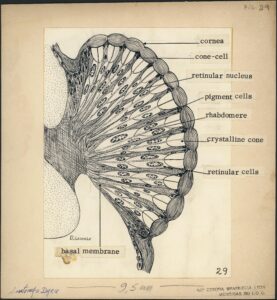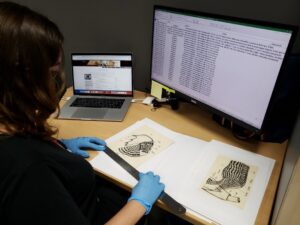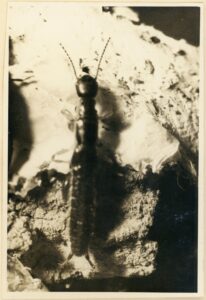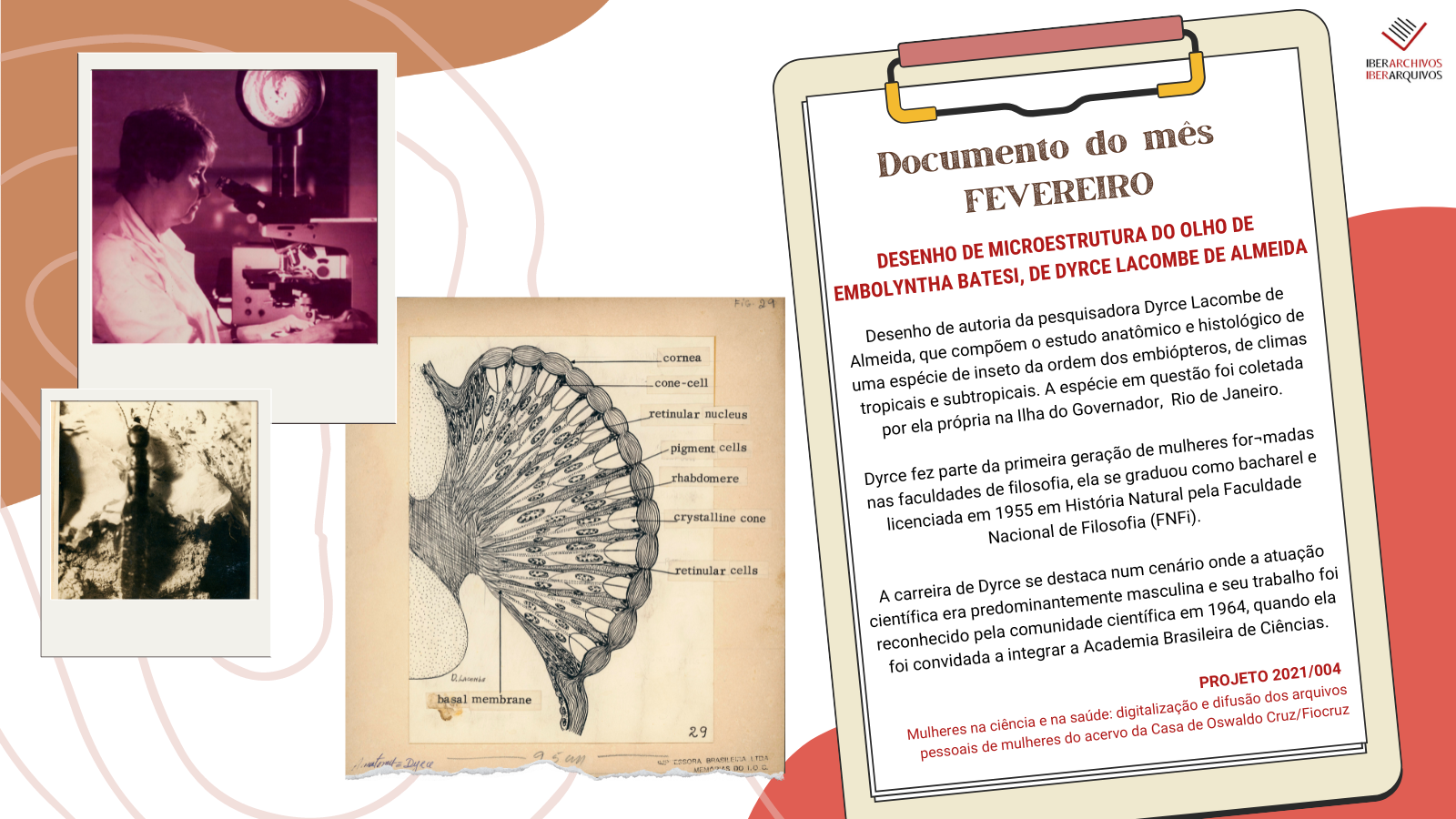On the occasion of Women in Science Day, we present a document that was the subject of our project “Women in science and health: digitisation and dissemination of the personal archives of women in the Casa de Oswaldo Cruz/Fiocruz collection”. It is a drawing by researcher Dyrce Lacombe de Almeida, 25.5 cm high by 23.7 cm wide, which is part of an anatomical and histological study of a species of insect of the order Embioptera, from tropical and subtropical climates. The species in question was collected on Ilha do Governador, a neighbourhood in the city of Rio de Janeiro. This type of study examines the interactions between structures and tissues, as well as their functions and the cellular organisation of a species, for example.
Drawing plays a fundamental role and cannot be replaced by photography because, although photography is quicker and easier to prepare, only drawing, using specific techniques such as shading, can highlight structures and shapes that would not be as clear with photographic capture. Scientific illustrations are therefore a recurrent type of document in the archives of scientists and are representative of science, especially in areas of biology such as entomology and botany. They are a visual resource of figurative representation that is fundamental to scientific research and development. Very present in the daily life of the laboratories of the Oswaldo Cruz Institute (IOC), it is also part of the life and career of Dyrce Lacombe, a researcher born in 1932 in Rio de Janeiro.
Her interest in science began when she was still studying at the gymnasium, the educational system in place in Brazil at the time. With the support of Newton Dias dos Santos, her high school teacher, she took part in the university extension course in zoology taught by him at the National Museum and in the specialisation course in General Entomology at the IOC, taught by researcher Rudolf Barth before she even started her degree. Dyrce was one of the first generation of women to graduate from philosophy faculties. In 1955, she graduated from the National Faculty of Philosophy (FNFi) with a degree in Natural History, combining her studies with a fellowship in Rudolf Barth’s laboratory. From then on, she began a fruitful research career with the researcher, working on the anatomy and histology of insects, mainly barbels.
In the following years she continued to teach at various institutions and in 1960 she joined the staff of the IOC, first as a National Research Council fellow and then as a biologist and researcher. During this period, she extended her field of study to crustaceans, with a particular interest in cirripedia (barnacles), establishing herself as a recognised authority in this field. Dyrce’s career stood out in a scenario in which scientific activity was predominantly male and her work was recognised by the Brazilian scientific community in 1964, when she was invited to join the Brazilian Academy of Sciences. Dyrce developed a wide range of international collaborations: in 1967 she received an invitation from the Osborn Marine Science Laboratories (New York) to conduct research on cichlids and, in 1969, she collaborated with the California Academy of Sciences to write a monograph on insects of the order Embioptera. He retired in 1991, but remained at the IOC to carry out his research on cirripedia, embioptera and histology of the bearded beetle.
The project “Women in science and health: digitisation and dissemination of the personal archives of women in the Casa de Oswaldo Cruz/Fiocruz collection” aimed to make these archives more visible and resulted in more than 4,000 documents being put online. Digitisation tends to favour the most consulted collections and those related to figures considered of greater historical prestige. As a result, women’s archives continue to be little consulted and forgotten, precisely because they are not the object of this attention. The project initiative aimed to overcome this logic that perpetuates the invisibility of women.
AUTHOR OF THE TEXT
Natalie Rickli Pimentel; Felipe Almeida Vieira
NAME OF IBERARCHIVOS PROJECT
Mulheres na ciência e na saúde: digitalização e difusão dos arquivos pessoais de mulheres do acervo da Casa de Oswaldo Cruz/Fiocruz
Bibliography:
– LACOMBE, Dyrce. Anatomy and histology of Embolyntha batesi MacLahlan, 1877 (Embiidina). Memórias do Instituto Oswaldo Cruz, Rio de Janeiro, v.69, n.3, p.331-396, 1971. Available at https://cutt.ly/YwCczKcy. Acesso em: 20 jan. de 2024.
– Lacerda, Aline Lopes de; Lima, Ana Luce Girão Soares de; Vieira, Felipe Almeida; Lourenço, Francisco dos Santos; Marques, Regina Celie Simões. A imagem a serviço do conhecimento: a entomologia nas ilustrações do acervo histórico da Fiocruz. Rio de Janeiro: Fiocruz/COC, 2022. Available at: https://www.arca.fiocruz.br/handle/icict/54874. Accessed on: 20 Jan. 2024.
– Oliveira, Ricardo Lourenço de; Conduru, Roberto. Nas frestas entre a ciência e a arte: uma série de ilustrações de barbeiros do Instituto Oswaldo Cruz. História, Ciências, Saúde – Manguinhos, Rio de Janeiro, v.11, n.2, p.335-384, Aug. 2004. Available at: https://cutt.ly/BwCcz6FO. Accessed on: 20 Jan. 2024.
– Pereira, Rosa Maria Alves (org.). Ilustração zoológica. Belo Horizonte: Frente Verso, 2016.
– Rossi, D. S., Ferreira, L. O., & Azevedo, N. (2021). Sociabilidades intelectuais, mediação cultural e recrutamento de mulheres em instituições científicas no Rio de Janeiro (1940-1960). Estudos Ibero-Americanos, 47(3), e40388. Available at: https://doi.org/10.15448/1980864x.2021.3.40388. Accessed on: 20 Jan. 2024.





